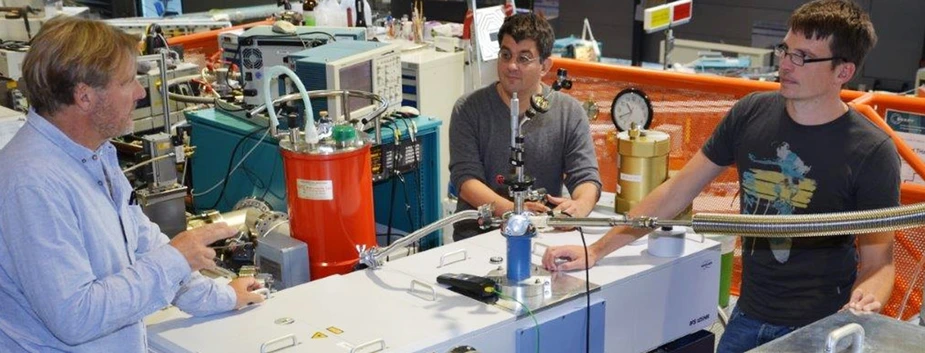New light shed on electron spin flips
HZB researchers enable calculation of EPR experiments
Researchers from Berlin Joint EPR Lab at Helmholtz-Zentrum Berlin (HZB) and University of Washington (UW) derived a new set of equations that allows for calculating electron paramagnetic resonance (EPR) transition probabilities with arbitrary alignment and polarization of the exciting electromagnetic radiation. The validity of the equations could be demonstrated with a newly designed THz-EPR experiment at HZB’s storage ring BESSY II. This progress is relevant for a broad community of EPR users and is published in Physical Review Letters on January 6 2015.
Electron spins are quantum objects with fascinating characteristics. They can be used as sensitive probes to explore material properties at the atomic level. Electron spins behave like tiny magnets that can be aligned parallel or anti parallel to an external magnetic field. Flips between these states may be induced by electromagnetic radiation matching the energy difference of the spin states. The probability for an EPR induced spin flip critically depends on the orientation of the magnetic component of the electromagnetic radiation with respect to the external magnetic field. These probabilities can be calculated, however, up to now respective expressions have been available only for a very limited number of experimental settings.
Set of equations for unconventional geometries
Joscha Nehrkorn, Alexander Schnegg, Karsten Holldack (HZB) and Stefan Stoll (UW) now succeeded to lift this restriction and derive general expressions for the magnetic transition rates, which are valid for any excitation configuration. The expressions apply to arbitrary excitation geometry and work for linear and circular polarized as well as unpolarized radiation. “We developed a general theory for EPR transition rates of anisotropic spins systems and implemented it in a freely available computer program. Thereby, EPR users can now interpret and predict experiments and extract highly desired information which was not accessible recently” explains Joscha Nehrkorn.
Tests have been successful
To test the new theoretical expressions, the authors employed the properties of a unique THz-EPR experiment at BESSY II. They aligned the spins of iron atoms incorporated in small organic molecules to a static magnetic field and excited them by linear polarized coherent synchrotron radiation in the THz range with varying orientations of the magnetic component of the THz radiation. By comparing the polarization dependence of theoretical predicted and experimental EPR line intensities, they could verify the newly derived equations and determine the parities of ground and excited high spin iron states. “This experiment is an excellent example how broad band THz radiation from a storage ring may be used for very high frequency EPR applications, these possibilities will be further boosted by BESSY VSR, the next generation of our storage ring,” states Karsten Holldack scientist at the THz beam line.
Alexander Schnegg who coordinates the project within a priority program (SPP 1601) of the German Research Foundation (DFG) further outlines: “The achieved breakthrough in EPR methodology strongly improves the predictive power of EPR for applications in e.g. life sciences, spintronics or energy materials research and paves the way for future EPR experiments with novel excitation schemes. “
Original publication:
General Magnetic Transition Dipole Moments for Electron Paramagnetic Resonance (Autoren: J. Nehrkorn, A. Schnegg, K. Holldack and S. Stoll), Physical Review Letters. (DOI 10.1103/PhysRevLett.114.010801)
More information:
Dr. Alexander Schnegg
Institute Silicon-Photovoltaics
Tel.: +49 (0)30-8062-41373
alexander.schnegg(at)helmholtz-berlin.de
Dr. Joscha Nehrkorn
Institute Silicon-Photovoltaics
Tel.: +49 (0)30-8062-41352
joscha.nehrkorn(at)helmholtz-berlin.de
Press Office
Dr. Antonia Rötger
Tel.: +49 (0)30-8062-43733
Fax: +49 (0)30-8062-42998
antonia.roetger(at)helmholtz-berlin.de
